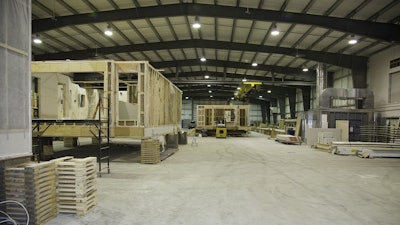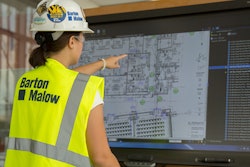
Contractors are facing business threats on many fronts — volatile economic conditions, disruptions in global trade and competition from new industry players all make it difficult for traditional construction players to keep their heads above the water. Contracting businesses can leverage the latest business models, tools and technologies to neutralize these threats and thrive, no matter the conditions.
Today, very few contractors enjoy profit margins much beyond 3% even during times of strong economic growth, and even large contractors can be just one failed project or market dip away from insolvency. To understand what causes this volatility we need to know where to look for potential threats.
Factors beyond your control — the global economy
A construction enterprise needs to be able to fund proactive growth to expand into new markets or invest in disruptive technologies, otherwise it will find it hard to compete in today’s economic landscape. But economic growth has already slowed and the World Bank has forecast slowing growth in all major advanced economies including the U.S., eurozone and Japan.
This is coupled with volatile materials cost, in part due to protectionist trade policies. Over the past year, material costs in the U.S. have increased by more than 7%, while years of expansionist trade policy have put project capital at a premium. This increase is due in part to a tight labor market — another challenge contractors have to contend with as the cost of their other inputs also creep up.
If the global economy were not enough of an existential threat to construction contractors, ignoring technology innovations can surely precipitate hitting the self-destruct button. Leading-edge technologies will be the determining factor making some contractors more competitive and others less competitive, not only on price, but in the degree to which they can drive value for project owners and expand into the lifecycle of the built asset for stable, recession-proof revenue streams.
When disruptors steal your thunder
Take modular construction for example: it’s a major area of growth, yet as large non-construction players including Ikea and Amazon are using innovative technologies to press into the modular construction space, traditional contractors may be missing out.
The good news here is that while individual contracting businesses can’t much influence geopolitics or what technologies large disruptors invest in, they can make key improvements to their own technological readiness and business models to withstand harsh economic conditions.
1. It’s BIM plus ERP — stronger together
Digital transformation tools such as building information management (BIM) and enterprise resource planning (ERP) software can provide a platform for management teams to stand on during uncertain times and adopt higher-margin business models — making them winners in their regional or global market.
But these technologies will not be able to transform the business significantly if operations aren’t built around a consistent, agile and complete software backbone. Most midsize and large construction contractors have implemented some form of enterprise resource planning (ERP) software. But often, they have only implemented financial and human resources modules, in part because the rest of a typical application suite is a poor fit for the business — this might be harming their profits without them realizing.
ERP’s power for construction companies is that it allows management to get control of their business by providing an accurate set of management information that enables predictable project performance and provides strong governance of their business. It enables projects to be delivered at lower cost, on time, at a high quality and with minimum risk—but it needs data to make this happen.
The end goal is to integrate the digital asset data held in the BIM models with the integrated ERP processes and in 2019, I believe we’ll see the construction companies take their first steps into discussing how to merge and build on the strengths of combining the two systems: BIM and ERP.
2. Critical revenue benefits of servitization — and how IoT can help
While downward price pressure has kept the margin on new construction around 3%, margin on service contracting can be as high as 14%. When contractors can make intelligent use of all of the data they have on the assets they deliver to a project owner, as required by BIM, they are in a position to sell maintenance and service contracts, becoming a strong strategic partner and gaining critical revenue and margin.
In order to realize these profits that can in turn fuel growth, the contracting business must have the systems and processes in place to manage entire asset lifecycles and treat the initial construction and maintenance contracts holistically. As the contractor moves into more complex servitized arrangements and becomes a full at-risk business partner with the project owner, this will further require intelligent application of transformational technologies including the internet of things (IoT) to drive compensation based on usage of the finished asset. By tracking performance on sensored equipment, IoT can help contractors capture hours of usage against a contract, eliminating manual accounting and enabling them to get the maximum out of the asset.
3. Weather the storm with off-site construction...and benefit from standardized parts
We have seen an increase in off-site fabrication for commercial and residential construction and it’s not hard to see why. Better use of labor will help address the shortage of skilled workers in the industry globally, not to mention a lower total cost and compressed project timelines. Work completed off-site, using manufacturing processes, is also not affected by inclement weather and can benefit from standard quality management and quality assurance processes common in a manufacturing setting.
But processes and software used in construction and manufacturing are vastly different, so contractors will require software environments that can encompass both disciplines seamlessly. Adopting a project-driven manufacturing solution can be a great way to overcome some of these limitations.
Offsite construction may help drive one other, and crucial, change in the way construction takes place—standardization of parts and materials. As the industry has not made significant moves towards a business model where a contractor has standard parts and components to design around, estimating in a construction environment typically takes place against a specification from the project owner. Project-driven manufacturing software can drive significant efficiencies here, by enabling contractors to work with owners to create unique projects that rely on standard components while also handling construction centric business processes and the time and resource constraints of site-based work.
4. The role of transformational technologies — before, during and after
As artificial intelligence (AI), robotics, and IoT become more commercially available, contractors can and should explore how the headline-grabbing technologies can help them change the way they do business.
Construction scheduling software such as 4D scheduling with AI algorithms can solve complex problems in real time that might be too complex for any human to handle. Leveraging IoT for projects may result in construction equipment being remotely operated in hazardous environments or when skilled operating engineers are in short supply.
But the greatest potential for IoT will come after project completion, when it can monitor structural members, mechanical systems and project integrity to support high-margin warranty and service and maintenance contracts. IoT sensors can also automatically update the databases that underpin BIM, and as the industry adopts predictive maintenance practices in the future, data from these sensors can also be run past algorithms that can predict structural or system failure, enabling a contractor to ensure the performance of an asset over its lifecycle.
Now your construction business can fly
Times are uncertain, but there is no uncertainty about the crucial role that modern business practices and digital transformation tools will play in determining which construction businesses thrive and which fall by the wayside.
Transformational technologies hold the potential to help construction contractors offer disruptive new services and even standardized products, but to make the most of them, contractors will have to implement enterprise-wide software infrastructures that can connect them to the way value and cost flow through the business.
Kenny Ingram is the Global Industry Director at IFS for the Construction, Contracting, Engineering, Infrastructure and Shipbuilding industries. He is alsoheavily involved in other Project and Asset Lifecycle industries including Oil and Gas, Energy, Utilities and Defense. Ingram's main responsibilities are to promote the IFS solution to the external marketplace and to educate the IFS workforce on business issues and challenges these industries face. Kenny has been with IFS for 16 years and has worked in the business systems marketplace for over 20 years.



















